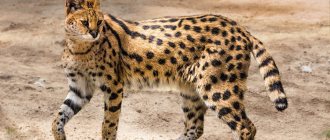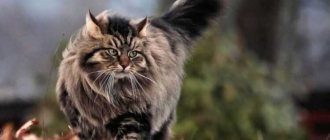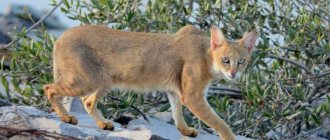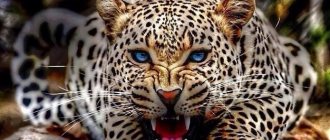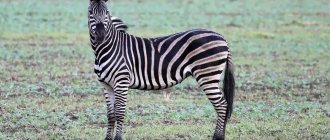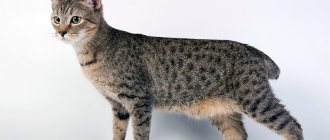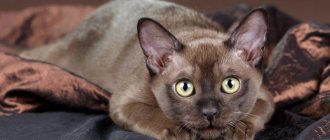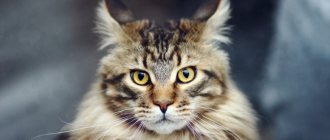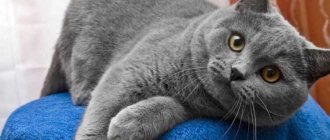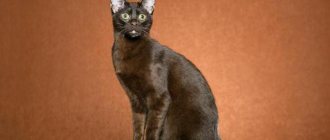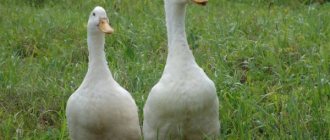| Origin | Türkiye |
| Wool | semi-long |
| Dimensions | weight 4-9 kg, height 35-40 cm at the withers |
| Lifespan | 15-17 years old |
The Van cat or Turkish van is a rare case - the variety has an aboriginal origin and an ancient history. For thousands of years, these animals interbred naturally, becoming the natural basis for most modern breeds. The name of the cats is associated with their homeland - a section of the Armenian Highlands near Lake Van. The species is characterized by excellent health, a stable phenotype and a gentle cat disposition.
Origin story
Agile shaggy cats - “vana katu” - were first seen near Lake Van: this body of water was considered part of ancient Armenia, and later passed to the Ottomans.
A Turkish legend says: when the devil decided to destroy Noah's ark, he threw a mouse into it so that it would gnaw a hole in its walls. But God, wanting to save humanity, sent her white cat to be destroyed. The furry huntress successfully completed her job, and as a reward, God touched her with his hand. The red marks on her fur are called God's tracks.
Merchants and crusaders exported cats to other continents. They did not gain much popularity there, but received a new name - ring-tailed cats. They became the ancestors of the modern Turkish Vans.
In the 50s, British journalist Laura Lushington took a pair of unusually beautiful kittens: a male and a female, from Turkish territory. They gave birth, and by 1994 these cats were recognized by most major cat fancier organizations. The name "Turkish cat" was changed to "Turkish van".
Turkey, which for a long time refused to recognize the uniqueness of its charges, eventually radically changed the principle, introduced a ban on the export of cats and declared them a national treasure. It is worth saying that only cats with heterochromia and snow-white fur deserve such a reverent attitude. But felinological organizations treat them in two ways.
Origin of the Turkish Van breed
There is a beautiful legend about the origin of the Turkish bath. The legend says that during a global flood, the devil sent a mouse to Noah's ark so that it would gnaw through the wooden hull of the ship. However, the mouse was quickly caught by a white cat swimming with other animals on the ark. God blessed the cat and touched it with his hand, after which red marks appeared on the animal’s body.
In reality, everything is much more prosaic. In 1955, English journalist Laura Lushington and her colleague Sonia Halliday brought two charming white and blue-eyed kittens from Turkey as a gift to them. On the way home, we accidentally discovered that the kittens were excellent swimmers. This was discovered when the women, tired of the hot sun, decided to take a dip in the lake, and the donated kittens, to the great surprise and delight of the English women, followed them into the water. Because of their love of swimming and fishing, it is often called the "fishing cat." Already in England, Laura began breeding unusual cats and even brought back more of the same kittens 4 years later. Already in 1969, the breed was known throughout Europe, and in 1973 they were included in the standard by the International Federation of Cat Fanciers.
Standards
Cats of this breed cannot be called miniature: the average weight of the animal is 6-9 kg. Moreover, males are outwardly larger and more massive than females.
| Standard | Description |
| Scull | Wedge-shaped, with minimal muzzle definition and a clearly defined chin. |
| Ears | Large, with a wide base and rounded tips. Both inside and outside the auricle is densely pubescent. |
| Nose | Small, the tip is colored soft pink. |
| Eyes | Large, open, slightly elongated. The color of the iris is blue or dark yellow. Different colored eyes are not considered a defect. |
| Torso | Small but strong, with a well-developed muscular corset, massive chest and strong neck. |
| Knees | Medium length, paws rounded, small. The pads are pale pink. |
| Tail | Reminiscent of a brush: covered with semi-long, thin hair. In summer the pubescence is quite sparse, but in winter it looks much more impressive and resembles a luxurious fan. |
| Wool | The undercoat is completely absent, and the coat itself is silky to the touch, semi-long. Longer on the hips and tail, shorter in the neck and shoulders. Summer cat “clothes” are light and airy, winter ones are heavier and thicker. |
These signs lead to disqualification:
- a clear “stop” on the bridge of the nose,
- no spots on the head,
- too many colored marks (more than 15% on the entire body),
- flat chest, underdeveloped fingers,
- creases and loops on the tail.
The cost of individuals of this breed is high, since this breed is rare. There is only one nursery in Russia, the rest are only abroad (in Canada, Turkey, USA). The price for 1 kitten ranges from 50,000 to 100,000 rubles. It is dangerous to buy animals from private breeders: you can run into unscrupulous sellers.
Price and where to buy a Turkish Van kitten
It is very difficult to find a kitten of this breed in Russia, but if you are lucky, its price can range from 7 to 30 thousand rubles. If the baby is brought from abroad, then the cost may even jump to 100 thousand rubles.
Naturally, a purebred kitten must have a birth certificate or pedigree and a veterinary passport. The baby must be active, with clean eyes and ears and at least 3 months old.
It is also worth remembering that in order to avoid deception, you should choose a pet with a specialist.
Colors
Classic color: white coat with ring-shaped prints on the tail and markings on the shoulder blades and between the ears. The markings on the head are colored cream, red, blue or black. Tabby marks are also common. The most common colors are blue, cream, brown and red. There are Turkish Vans with torbi spots (including diluted ones) and tortoiseshell.
In the photo there are cats of the Turkish Van breed of popular colors
It happens that paticolor and bicolor babies are born, the percentage of white wool in which takes up half or more of the total wool. Experts do not like this kind of outcrossing (adding blood from another breed).
How to choose a kitten
Rare Van cats, photos of which can be seen on the Internet, are not available for free purchase. Under no circumstances should you trust private advertisements or offers to buy a van without documents. First, you will have to reserve the baby from an official breeder who is registered with the international felinological club.
Do not forget that a kitten, even in its native Turkish nursery, must be healthy and also correspond to the description of the breed.
When choosing a pet you should consider:
- breeder's reputation;
- availability of a veterinary passport;
- purity of pedigree;
- baby's appearance.
To be able to assess the development and condition of Van, the kitten should not be younger than 3 months. The animal must eat independently, have a well-fed, strong body, and behave actively and inquisitively.
Character and behavior
If the Turkish van wants entertainment, neither your sidelong glances nor the limited space will interfere with him. At the same time, the cat will try to attract everyone nearby to the game, offering a toy to you, your dog, and the parrot in the cage. The Vans will not climb onto the highest cabinet and throw a couple of obviously unnecessary souvenirs off the shelf, and then sit down and watch the surrounding commotion.
These cats simply love to swim. As they say, don’t feed him bread, let him swim to his heart’s content. Therefore, any trickle of water and any container with life-giving moisture arouses his genuine interest.
And if there are fish in the pond, turn off the lights. The Turkish van will not rest until he catches every single one. So keep a close eye on your aquariums.
Turkish Vans are not intrusive, but will always hang out somewhere next to a person with a proud and independent appearance, but with a clear bit of curiosity. These are true leaders and completely independent individuals, so they and only they will decide: when to go eat, when to sleep, and when to allow themselves to be showered with a portion of affection. Moreover, it is cats who are more stubborn in this matter, while cats are more docile and relaxed. In cat families, the main ones are always females.
There are no authorities for Van, so be prepared for confrontation. Naturally, you need to start raising a kitten literally from the first days, when he begins to more or less think, however, if something gets into his head, he will defend his position to the bitter end. The cat will definitely have a favorite, but the furry “king” will try to lead them.
According to folk wisdom, what should happen if a cat washes itself?
Receive a letter Guests will come
They have excellent memory, which allows them to build cause-and-effect relationships and calculate the situation in advance. It is useless to beat them, as well as to raise your voice: they will be offended and, possibly, take revenge. A punishment that will work: deprivation of tasty food and your communication.
Standard color requirements
A common requirement for all cats of this type (van, bicolor, tricolor, harlequin) is a clear separation of spots of different colors on the surface of the fur. That even a white hair should not penetrate the painted area. Based on these requirements, the pattern on wool looks like a colored mosaic of archaically arranged elements. The nose and pads on the cat's paws are colored according to the main color of the fur coat. The rich golden-orange color of the eyes indicates a high percentage of coloring pigment in the cornea.
British Shorthair from 01 62
Highland fold red harlequin – SFL d 02
Care instructions
Turkish vans are very clean. They demand from the owner a perfectly clean tray, after each visit to the toilet they will bury their excrement for a long time and diligently, and dissatisfiedly move the bowl of dirty water. If the owner turns out to be slow-witted and does not correct the situation in time, he will find a cleaner corner for the toilet, and stick his nose into the toilet in search of clean water.
Wool
To keep your pet looking neat, the grooming schedule should be as follows: brush it once a week with a classic brush with natural bristles, starting from the head.
Bathing - no more than once every 4 months. Despite the Vanir’s love of bathing, frequent water procedures do not benefit them: the protective layer is washed off from the body, which can provoke all sorts of inflammation.
Ears
The ears are examined once every 2 weeks: have ear mites settled inside? Has a sulfur plug formed? Contaminants are removed with a cotton swab soaked in ear lotion or hydrogen peroxide.
Teeth
The Vanir's eyes do not cause concern, but they will have to take special care of their teeth: they deteriorate quickly in cats and are difficult to treat. If your cat refuses to brush its teeth, take it to the dentist for ultrasonic teeth cleaning, and add a special cleaning gel to the water.
Claws
Vans successfully use a scratching post to shorten claws, but if you notice that your cat is being lazy, trim the claws yourself. You can buy a special nail clipper, or you can use regular manicure scissors.
In the photo, a Turkish Van cat is fishing
Advantages and disadvantages
The Turkish Van cat has many positive qualities:
- special wool with a soft texture, lack of undercoat and unique properties;
- high intelligence and learning abilities;
- quick adaptation to conditions of detention;
- good health with natural immunity.
Along with its advantages, the van has some disadvantages:
- high cost due to the rarity of the breed and the difficulty of exporting from Turkey;
- there is a high chance of encountering scammers when searching for a kitten;
- the dominant character of the Van;
- the need to pay a lot of attention and spend time playing with the pet;
- mandatory bathing and dental care.
Catering
Natural products
Natural food is good because you can always buy fresh food and, from time to time, pamper your pet with new cereals or cutlets.
From natural products it is allowed to give:
- lean boneless meat (beef, veal, chicken, lamb and turkey);
- fish (flounder, trout, salmon, navaga);
- fermented milk products (cottage cheese, yogurt, sour cream, cream, fermented baked milk, natural yogurt);
- porridge (rice, millet, semolina, buckwheat, oatmeal);
- stewed or boiled vegetables (pumpkin, zucchini, carrots, asparagus, broccoli, cucumbers);
- fruits (melon, apple, pear, watermelon).
You should not feed your Turkish Van food that is fatty, fried, smoked, salty or sweet. Seasonings, pickled vegetables, flour, baked goods, many vegetables (potatoes, tomatoes, peas, eggplants) and fruits are prohibited!
Recommended food
Breeders from the USA and Canada strongly recommend feeding Vans with high-quality ready-made food. These include holistic and super-premium food. These are expensive, but high-quality feeds made from high quality products.
Contains: dehydrated meat and fish, dried berries, fruits and vegetables, a good vitamin and mineral complex has been added. Examples of holistic foods: Nutram, Carnilove, Farmina N&D. Super-premium food: ProSeries, Fitmin For Life.
Economy food classes: Whiskas, Nasha Marka, TerraKot and premium are lower in quality and are not worth buying without unnecessary need.
Below are recommended super-premium foods. Links with the names of the food are clickable, on them you can, within our website, get acquainted with the descriptions of the food and read reviews from owners of Turkish Van cats.
| Holistic | Super premium | Super premium |
| Primordial | Guabi Natural | 1st Choice |
Turkish Vans are prone to obesity, so do not overfeed the animal and do not teach it to snack between meals.
You can only drink clean filtered water. It can be settled, bought distilled, or purified using a kitchen filter.
Health of Turkish Van cats
Turkish Vans are distinguished by relatively good health and good immunity. Unless they may develop hypertrophic cardiomyopathy, that is, thickening of the wall of one of the ventricles of the heart. But with good therapy, a cat can lead a completely happy life.
Well, like all white-haired cats, when crossing two white individuals, there is a high probability of the birth of a kitten with deafness. Otherwise, this is a healthy breed, not prone to any specific diseases, living up to 15 years, which is a respectable age for them.
Diseases
Since the Turkish Van is an aboriginal breed, they have fewer genetic pathologies than hybrid breeds. However, health problems still arise. Let's list the main ones:
Hypertrophic cardiomyopathy is an insidious disease that, unfortunately, cannot be completely cured, but can be “suppressed” and alleviate the pet’s general condition. It is expressed in thickening of the left cardiac ventricle and the septum between the ventricles (while the ventricular cavity itself is greatly reduced).
The disease occurs more often in males: the animal becomes more lethargic, suffers from shortness of breath, tachycardia, breathes heavily, and a murmur is heard in its heart. Pulmonary edema gradually increases, fluid accumulates in them, pressure increases, and partial paralysis occurs. The cough is completely absent. Catalyst: prolonged stress, illness, infusion therapy carried out without proper calculations of the speed and volume of fluid. Treatment is medication; in severe cases, it occurs in a hospital.
The weakest point of the Turkish Van is the gums and teeth. The gums often become inflamed, and tartar builds up on the teeth. Other diseases also appear. Therefore, it is important for you to monitor this from the very beginning: choose the right care products, brush your teeth regularly, and regularly take your animal for examination to the veterinarian.
Expert opinion
Dusheba Vera Ivanovna
In 2010, she graduated from the Moscow State Academy of Veterinary Medicine named after K.I. Scriabin with honors, specializing in veterinary medicine. I regularly attend veterinary conferences, congresses, and webinars.
Do not refuse vaccination, even if your cat is indoors and, in your opinion, is completely protected. This is not true: pathogens of such dangerous diseases as panleukopenia, rhinotracheitis and others easily enter your home on clothes or hands.
Health
The Van breed has good health, thanks to its natural origin and long-term free crossing. Turkish cats are not prone to any diseases that are unique to them. Like all cats, Vans are often born with hypertrophic cardiomyopathy, which is characterized by symptoms such as lethargy, shortness of breath, and apathy. The disease has no cure, only supportive therapy.
Due to genetic characteristics, it is not recommended to cross two animals of pure snow-white color. This significantly increases the risk of producing kittens with hereditary deafness.
The dominant allele of the white coat genes affects the formation of the inner ear and causes a mutation in the early stages of embryonic development. If at least one van in a pair has a colored color, then the chance of having deaf kittens is significantly reduced.
The Turkish cat is characterized by a high level of immunity, rarely catches colds and is able to cope with simple viruses on its own. And to prevent dangerous diseases, it is enough to follow the vaccination regime and carry out deworming in a timely manner.
Poor nutrition or improper care can cause:
- allergies;
- hormonal imbalance;
- gingivitis;
- arterial thromboembolism;
- urolithiasis.
If you give your pet proper attention and care, the van will live at least 15 years.
Photo gallery
Below are photos of Turkish Van cats.
What is the price
Turkish Van kittens are so rare in Russia that they are highly valued. An animal with a full set of documents will not cost less than 20 thousand rubles. The absence of a metric most often indicates a mestizo or a completely outbred cat.
The price of a high-quality cat with a good pedigree, brought from abroad, will be even higher - 30-100 thousand. When buying a van in Turkey, it is worth considering that in order to export a kitten you will have to obtain a special permit. In addition to its native country, the breed is bred in the USA, Germany and the Netherlands.
Legend
In the homeland of these representatives of the cat tribe, there is a beautiful legend about these miracle cats.
When Noah finished building his ark, the devil decided to interfere with saving lives and launched a small mouse onto the ship. He had to gnaw through the logs of the ark so that the ship would sink to the bottom.
But God learned about the insidious plan of his eternal enemy and ordered the snow-white cat to neutralize the rodent. When the cat complied with the request, God stroked it with his hand, causing red spots to appear on the animal’s fur.
These cats are highly revered in Turkey. It is believed that to harm this animal is to commit a great sin. And the person who kills Van must build seven mosques, all at his own expense.
Peculiarities
This breed is also sometimes called the Turkish Van water cat. This is explained simply. Among the purring four-legged animals, you don’t often meet those who are calm about water.
Vans love to swim. The structure of their coat helps them to tolerate contact with water calmly. The cashmere-feel of the wool is actually water-repellent.
Background of the breed
“Girl with a White Cat”, Antoine Jean Bayle (1830-1918)
Before the birth of felinology in its modern form and the felinological movement, these cats were known as “vana katu” - which is translated from Armenian as the cat of Van or the cat of Lake Van.
It is believed that the first Van cats were brought to Western Europe by the Crusaders returning home. European travelers who visited Western Armenia, starting from the 17th century, repeatedly mentioned and described these cats. However, in most cases, all long-haired cats in those days were called Angora, regardless of color and body structure. In particular, the French archaeologist, architect and artist Pierre Victor Lottin de Laval (French: Pierre-Victorien Lottin
), who traveled throughout the Middle East (through the territories located between Ankara and Baghdad, to the Armenian Highlands, Kurdistan and Persia) in a letter dated May 11, 1856, gave a description of long-haired cats of different colors:
I myself have met specimens of this beautiful breed of cats in the great Armenian plateau in Erzurum, where the climate is very different from that of Angora. This breed is very numerous in Murcha in Kurdistan[40], where it is the dominant variety. I also met them in Bitlis and the Pashalik of Bayazet. However, the best examples I saw belonged to the Archbishop of Van, a city in eastern Kurdistan, on the border with Azerbaijan. He had three of these cats: one was pearl gray, another was orange with black and white spots, and the third was completely white. Their fur was magnificent, although no one was surprised by them, since such cats are widespread in Kurdistan. I also saw several of these cats in the residence of Khan Mahmud, Prince of Gekiars, in Alpeita[/td]
.
Brought to different eras, Van cats were known in Europe under different names. They were called both white ring-tailed cats and Russian Angoras. Most Van cats were exported under the guise of Angora cats, and usually even Vans with a Van color were called white Angora cats. So in the painting by the French artist Antoine Jean Bail
) (1830-1918) “Girl with a White Cat” depicts a Van cat of the traditional Van color.
Perhaps the crimson markings on cats were perceived by our ancestors as being left by the sun or as a blessing from a pagan solar deity.
Links[edit]
- ^ abcd "Turkish Van cats". Retrieved April 8, 2014. This tertiary source reuses information from other sources but does not name them. As with many other sources, this one conflates the formal Turkish Van breed, which is actually British, with the native Landrace Van cat of Turkey, and should therefore be interpreted with caution.
- ^ a b "Wan Kedisi". “VanKedisi.net: En Güzel Kedilerin Sitesi
(in Turkish). Archived from the original on February 13, 2013. Retrieved February 12, 2013. Machine translation into English. - [1] Archived July 18, 2006, at the Wayback Machine.
- ^ abcde Pond, Grace, ed. (1972). The Complete Encyclopedia of Cats
. London: Walter Parrish International. p. 114. ISBN 0-517-50140-6. This tertiary source reuses information from other sources but does not name them. - ^ abcdef Tabor, Roger (writer/host); Crowther, Stephanie (researcher) (1991). "Aristocrats". Cats
.
Episode 5. Event occurs at 03:50–13:20. BBC 2. The documentary distinguishes the mostly feral white Van cats (the type identified as such by the locals of Van) from the brown Turkish Van breed, agreeing with other sources that the latter was bred by the British in 1955 from a Turkish breed. This information is also presented in Tabor's companion book, Cats: Rise of the Cat
, ISBN 978-0563360117 (1995). - Lushington, Laura (1963). "Floating cats". Animals
.
1
(17): 24–27. - "Recognized and accepted breeds in the WCF". WCF-Online.de
. Essen, Germany: World Cat Federation. 2012. Archived February 13, 2013. Retrieved February 13, 2013. - Sample, Ian (19 June 2022). "Africans to Purr-ymids: DNA Study Reveals Long Tale of Cat Domestication". theguardian.com
. Retrieved June 19, 2022. - Ottoni, Claudio; Van Neer, Wim; De Cooper, Bea; Daligo, Julien; Guimarães, Silvia; Peters, Joris; Spasov, Nikolay; Prendergast, Mary E.; Boivin, Nicole; Morales-Muñiz, Arturo; Balasescu, Adrian; Becker, Cornelia; Beneke, Norbert; Boroneant, Adina; Buitenhuis, Hijlke; Chahud, Jwana; Crowther, Alison; Llorente, Laura; Manaseryan, Nina; Monchaux, Herve; Onar, Vedat; Osipinskaya, Marta; Putela, Olivier; Quintana Morales, Erendira M.; Studer, Jacqueline; Wierer, Ursula; Decorte, Ronnie; Grange, Thierry; Geigl, Eva Maria (2017). "Paleogenetics of cat dispersal in the ancient world." Nature, ecology and evolution
.
1
(7):0139. DOI:10.1038/s41559-017-0139. ISSN 2397-334X. - ↑
Rob Stein, Washington Post (March 23, 2008). "Using DNA to trace the ancestry of cats". Sfgate.com. Retrieved November 30, 2011. - Lipinski, Monica J.; Froenicke, Lutz; Baysac, Kathleen C.; Billings, Nicholas S.; Leutenegger, Christian M.; Levy, Alon M.; Longerie, Maria; Niini, Tirri; Ozpinar, Haydar (2008). "The Rise of Cat Breeds: Genetic Assessment of Breeds and Random Populations Around the World". Genomics
.
91
(1):12–21. DOI: 10.1016/j.ygeno.2007.10.009. PMC 2267438. PMID 18060738. - ↑
Vinogradov, A. E. (1994).
"Locally associated alleles of cat hair genes". Journal of Heredity
.
85
(2):86–91. DOI: 10.1093/oxfordjournals.jhered.a111428. PMID 8182285. - Paruyr Sevak, “On the Unsilenceable Belfry” (Պարույր Սեւակ, ԱՆԼՌԵԼԻ ԶԱՆԳԱԿԱՏՈՒՆ), published in 1959: “… Թե
ազատվելու ??????????????????????????????????????????????????????????????????????????? - "Armenian vans are real" aristocrats "". Tour in Armenia
. TACentral.com. Retrieved July 17, 2009. - ^ ab Sor, Dara (11 January 2006). "Kurdish National Pride: Pishika Vane - Van Cat". Land of the Sun: Kurdistan
. BlogSpot. Retrieved December 13, 2011. - Hart, Robert (2010). Hart's Original Petpurri Vol. 1
.
Langdon Street Pr. item 4. ISBN 9781934938621. Hart cites an article from Cat Fancy
as a source. - Wright, Michael; Walters, Sally (1980). The Cat Book
(1st ed.). London: Pan. pp. 50–52. ISBN 0-330-26153-3. - "Turkish Van, Swimming Cat". Magazine "Cats and Kittens"
. Pet Pubg. 2000. Archived from the original on December 4, 2007. Retrieved July 15, 2009. - Van City Guide
.
Ankara. 2005[ clarification needed
] - //www.turkishangoracat.org/arastirma.aspx?arastirmaId=2
- "Guide to Van City", Ankara, 2005.
- "Turkish Van Breed Profile". Archived from the original on March 5, 2016. Retrieved January 14, 2022.
- "Verimli yılın kedisi 500 TL". Hurriyet.com.tr
. Retrieved December 15, 2022. - "Yönetmelik: Yerli Evcil Hayvan Genetik Kaynaklarinin Kullanilmasi Ve, Yurt Dişina Çikarilmasi Hakkinda Yönetmelik ['Regulation: use of genetic resources and domestic animals, regulation on movement abroad']". Resmî Gazete [Official Gazette]
(in Turkish). Ankara, Türkiye: Ministry of Food, Agriculture and Livestock. September 21, 2012. Issue 28418. Archived February 13, 2013. Retrieved February 12, 2013. Machine translation into English. - "2010 FIBA World Cup Events Guide: Mascot". FIBA. Archived from the original on September 14, 2010. Retrieved September 12, 2010.
- "One Cats". TACentral.com
. Tacentral.com. 2011. Traveling through Armenia, history, archeology and ecology | TourArmenia | Guide to Armenia. Archived from the original on July 5, 2014. Retrieved February 28, 2015. - Values provided by the file: Armenian population of Van province in 1896.png
- Gebhardt, Richard H. (1995). The Complete Book of Cats: Expert Advice for Every Stage of Cat Ownership. paragraph 159.
- ^ ab Conway, Dina J. (1998). Mysterious, magical cat
. Llewellyn Publications. p. 190. ISBN 978-1567181807. The Turkish Van (pronounced von) gets its name from Lake Van in western Turkey, but is actually an Armenian cat. The Armenian people settled in the area of Lake Van and revered this breed of cats. Like many others, this source incorrectly equates the modern Turkish Van breed, which is actually British in origin, with the Landrace Van cat. - ^ a b Muradian, Karlen (1980). The Many Worlds of Arshile Gorky
. Gilgamesh Ave. S. 84, 87. - Landau, Ronnie S. (1998). Holocaust Studies: Issues, Readings and Documents. paragraph 101.
- ^ ab Waldman, Diane (1981). Arshile Gorky, 1904–1948: a retrospective
. H. N. Abrams Books. item 255. - Papazian, Vrtanes (1988). Vana Katu
. Yerevan: Arevik Publishing House. - Raffi (1884). Կայծեր [Sparks] Book II
(in Armenian). Գալով այդ քաղաքը, թեեւ ծիծաղելի է, բայց պետք է խոստովանվիմ, որ իմ ամե ?????? "Rough translation:" Even though it's funny, I have to admit that coming to the city one of my biggest expectations was to see the famous Van cat. - Bakunts, Axel (1927). Մթնաձոր [Dark Valley]
(in Armenian). Ներս մտավ պառավը, Վանա կապույտ փիսոն հետևից. Approximate translation: “The old woman entered after the Van cat. - ↑
Sevak, Paruyr (1959).
Անլռելի զանգակատուն [Silent bell tower]
(in Armenian). Լող էին տալիս հազա՜ր ու հազա՜ր Վանա կատուներ ՝ Վառվող աչքերով. Rough translation: “Thousands of Van cats swam with glowing eyes. - Grossbongardt, Annette and Sand, Bernhard, "Kurdish Katzen", Der Spiegel 44/2007
- ^ ab Zaman, Amberin (6 October 2000). "German group pounces on 'eradication' of Kurdish cats". Los Angeles Times
. - ↑
Karen Hooker (October 14, 2000). "Turkish Van No. 3". Swimcats.com. Retrieved November 30, 2011.
Van cat in literature and fine arts
“Lady with a Cat”, Margaret Gerard (1761-1837)
The Armenian classic writer Raffi (1835-1888) gave a description of the Van cat in his novels “The Diary of a Cross Thief” (1890) and “Sparks” (1883-1887). The famous Armenian writer and playwright, a graduate of the University of Geneva, Vrtanes Papazyan (1866-1920), who was born in Van, where he spent his childhood and youth, wrote a short story “Vana katu” - “The Cat of Van”, which gave the name to the collection of stories. One of the communist leaders of Armenia in the mid-1920s was said to be as red as the tail of a Van cat. The famous Armenian writer Axel Bakunts (1899-1938) described the Van cat in the story “In a Dark Gorge” (1927). The outstanding Armenian poet of the 20th century, Paruyr Sevak, also mentioned Van cats in his poem “The Incessant Bell Tower” (1959). The image of the Van cat is also found on items of Armenian decorative and applied art, including carpets.
Apparently, the earliest depiction of a Van cat in Western European painting is the portrait “Lady with a Cat” by the artist Margaret Gerard (1761-1837).
GALLERY OF PHOTOS OF BRITISH CATS, CATS, KITTENS OF COLOR BI-COLOR, HARLEQUIN, VAN, TRI-COLOR
Lilac color with white British cats. Lilac bicolor British
Red (fawn) color with white British cats. Red (fawn) bicolor British
| In our cattery you can “buy a real British kitten.” We have many different colors, we will help you choose and answer all your questions! |
